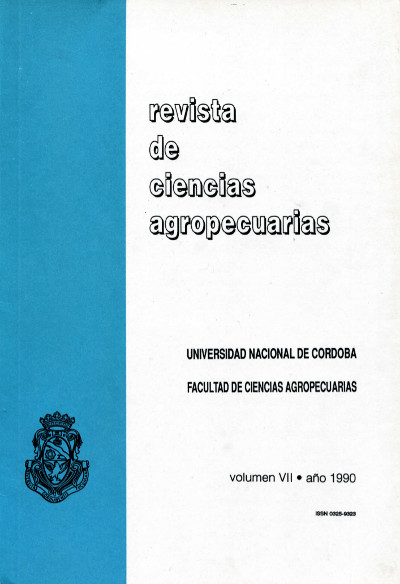Water regions of the Republic of Argentina
Main Article Content
Abstract
The definition, delimitation, and characterization of different hydric regions of Argentine from the hydrologic budget and rainfall characteristics, are very important in order to know the cattle, forestry and agricultural potential of a zone. A statistical multivariate classification technique is used, known as cluster analysis. The cluster analysis is applied to a set of variables (average deficit and excess of water, average monthly deficit and excess of water, equilibrium and stationarity of rainfall), collected from all over the country to define geographical units of homogeneous hydric characteristics. Cluster analysis allowed to delimit fifteen hydric regions in Argentine and thus obtain the associated mean values of the agroclimatic parameters.
Article Details
Issue
Section

This work is licensed under a Creative Commons Attribution-ShareAlike 4.0 International License.
How to Cite
References
Burgos, J. J., & Vidal, A. L. (1951). Los climas de la República Argentina según la nueva clasificación de Thornthwaite. Meteoros, 1(1), 3-32.
Cabrera, A. L. (1972). Regiones Fitogeográficas Argentinas. En L. Parodi (Ed.), Enciclopedia de Agricultura y Jardinería (Segunda ed., p. 85). Acme.
Da Mota, F. S. (1974). Tipos de balanco hídrico no Brasil. Ciencia y Cultura, 26(8), 766-744.
Munn, R. E. (1970). Biometeorological Methods. Academic Press.
Pascale, A. J. (1972). Analysis of air temperature and soil moisture. Agricultural Meteorology WMO No. 130, Proceedings of the WMO Seminar on Agricultural Meteorology, Barbados, November 1970, 338-347.
Pinto, H. S., & Preuss, A. (1975). Uso do computador no calculo do balanco hídrico climático. Rev. Turrialba, 25(2), 199-201.
Prego, A. J., & Otros. (1963). Las tierras áridas y semiáridas de la República Argentina. IDIA, 186, 1-52.
Ragonese, A. E. (1967). Vegetación y Ganadería en la República Argentina. INTA (Col. Científica Vol. V).
Reddy, S. J. (1983). Agroclimatic Classification: Numerical-Taxonomic Procedures - A Review. Rev. Pesq. agropec. bras., Brasília, 18(5), 435-457.
Servicio Meteorológico Nacional. (1958a). Estadísticas climatológicas 1901-50 (Publ. B1 No. 1). Buenos Aires.
Servicio Meteorológico Nacional. (1958b). Estadísticas climatológicas 1941-50 (Publ. Serie B No. 3). Buenos Aires.
Servicio Meteorológico Nacional. (1960). Atlas climático de la República Argentina. Buenos Aires.
Servicio Meteorológico Nacional. (1972a). Estadística climatológica 1951-60 (Publ. Serie B No. 6). Buenos Aires.
Servicio Meteorológico Nacional. (1973). Datos Pluviométricos 1921-50 (Publ. No. 2). Buenos Aires.
Servicio Meteorológico Nacional. (1981). Estadísticas climatológicas 1961-70 (Publ. Serie B No. 35). Buenos Aires.
Sparks, D. N. (1973). Euclidean Cluster Analysis. Applied Statistics, 22(1).
Thornthwaite, G. W., & Mather, J. R. (1957). Instrucciones y tablas para el cómputo de la evapotranspiración potencial y el balance hídrico. Instituto de Suelos y Agrotecnia, INTA (Tirada interna No. 46). Buenos Aires.
Thornthwaite, G. W., & Mather, J. R. (1975). The Water Balance. Drexel Institute of Technology. Publications in Climatology, Volume VIII No. 1. Centerton, New Jersey.





